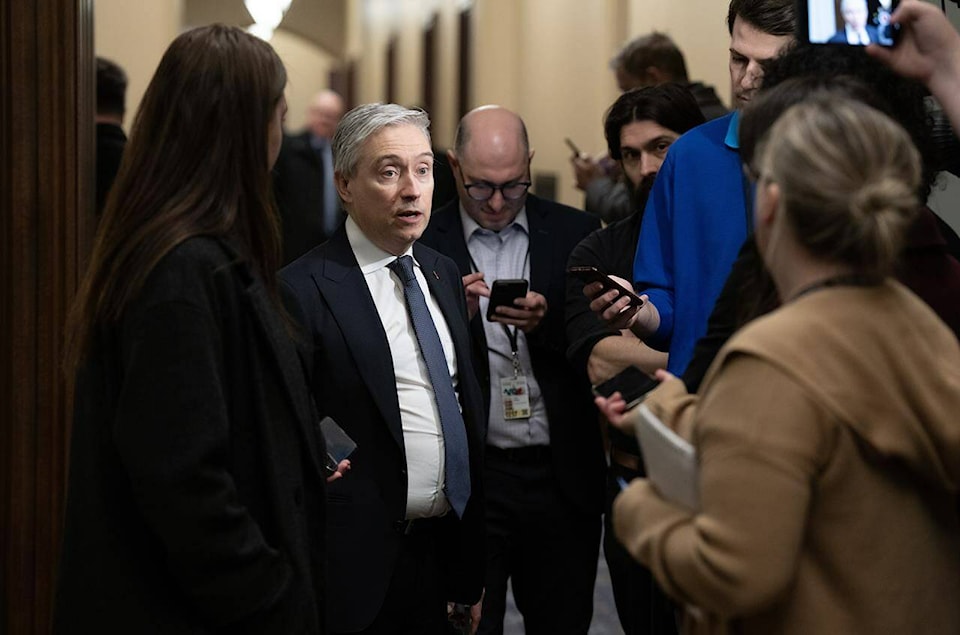The federal minister responsible for innovation and industry says Canada could be at risk of losing out on attracting green industries if it doesn’t consider all options for renewable electricity, which he says include nuclear power.
François-Philippe Champagne said in an interview with The Canadian Press that he considers nuclear power part of the renewable energy portfolio that needs to grow to support the country’s lean into “the economy of the 21st century.”
“Nuclear, definitely,” Champagne said on Friday. “For me, we have to look at hydro, we have to look at nuclear, we have to look at small modular reactors, we have to look at wind, we have to look at solar.”
Small modular reactors are a type of advanced nuclear power plant that the International Atomic Energy Agency says can be prefabricated and shipped to sites unsuited to larger conventional reactors. The federal government has previously said it wants to become “a global leader in SMR deployment.”
“I can tell you when investors are calling me, they are not looking for subsidies,” said Champagne. “They are looking for renewable energy, they’re looking for talent, they’re looking for the right ecosystem, they’re looking for access to market. So, I would say that today, renewable energy is key to attracting investment, and that’s why we’re going to be there.”
Canada has announced a number of new investments designed to integrate into global green supply chains in recent years. They include a billion-dollar battery plant expansion in Maple Ridge, B.C., that was unveiled last November and is aimed at producing up to 135 million batteries a year.
Officials from battery maker E-One Moli said one of the reasons its Taiwanese parent company chose Canada for the expansion is the availability of sustainably produced electricity.
Champagne said in a previous interview that Canada was reaching its renewable energy production limits, something he reiterated in Vancouver while pointing to nuclear technology as a key part of the solution.
“I think you have to look at all the renewable sources of energy, and I think certainly British Columbia like Manitoba or like Quebec has been blessed with hydro power,” he said.
“Oftentimes, I say we live out of the dividend of people who came before us in terms of renewable energy. Now, for us, I think the dividend that we need to leave to the next generation is to make sure that we make the investments now so we will continue to have the power to develop our natural resources in a sustainable and responsible way. And obviously, renewable energy has become key.”
York University professor of environmental and urban change Mark Winfield said the federal government’s recent inclusion of nuclear power among options for decarbonizing electricity production is troubling.
“Yes, compared to fossil fuel sources (nuclear) is relatively low carbon, depending on certain assumptions,” Winfield said. “But it carries with it a huge, a very serious range of negative trade-offs. It essentially fails every other test of sustainability.”
Among Winfield’s concerns are typically high initial capital costs during construction of nuclear plants, which have previously included cost overruns and delays in Canada.
He said he also worries about the management of nuclear waste “on time scales of a million years” as well as the impact of uranium mining.
Industry proponents point to nuclear power’s dependable nature, since it doesn’t rely on weather conditions that can affect solar and wind generation.
George Christidis of the Canadian Nuclear Association said the strength of nuclear power was its ability to provide “non-emitting base load power generation, which basically means that it provides a foundation in an energy system and an energy mix.”
“That means more clean energy generation that then helps to decarbonize other sectors,” he said.
Christidis said while nuclear plants have high initial capital costs, those costs are amortized over a longer period compared to other power plants, meaning more stable costs than facilities at the whim of fluctuating fossil fuel prices.
He said the potential for small modular reactors is huge, as other countries will look to Canada to produce such reactors for decarbonizing power generation.
Within Canada, smaller nuclear reactors of various sizes are being planned or explored in Ontario, Saskatchewan and Alberta, and Christidis said they could be “fundamental to shifting away from the use of coal” in these provinces.
“The applications (of SMRs) to widen the transition into these clean energy solutions in the small reactor space, they’re very real,” he said.
Winfield, however, said people should be skeptical because the small modular nuclear reactors being discussed are designs that have not been realized.
“Nobody has built an SMR anywhere,” he said. “This is part of the problem; they don’t exist, even as prototypes.”
Winfield said, even beyond the cost and waste management aspects, nuclear power presents too much risk to warrant consideration as part of Canada’s bid to bring more green industry online.
“You have catastrophic accidents, safety, security, weapons proliferations, risks that just don’t exist in relation to any other energy technology … all of which would suggest that this technology would be an option of absolute last resort when all other options around decarbonization have been fully developed and optimized,” he said.
“I don’t think we’re anywhere near that in Canada at this stage.”


